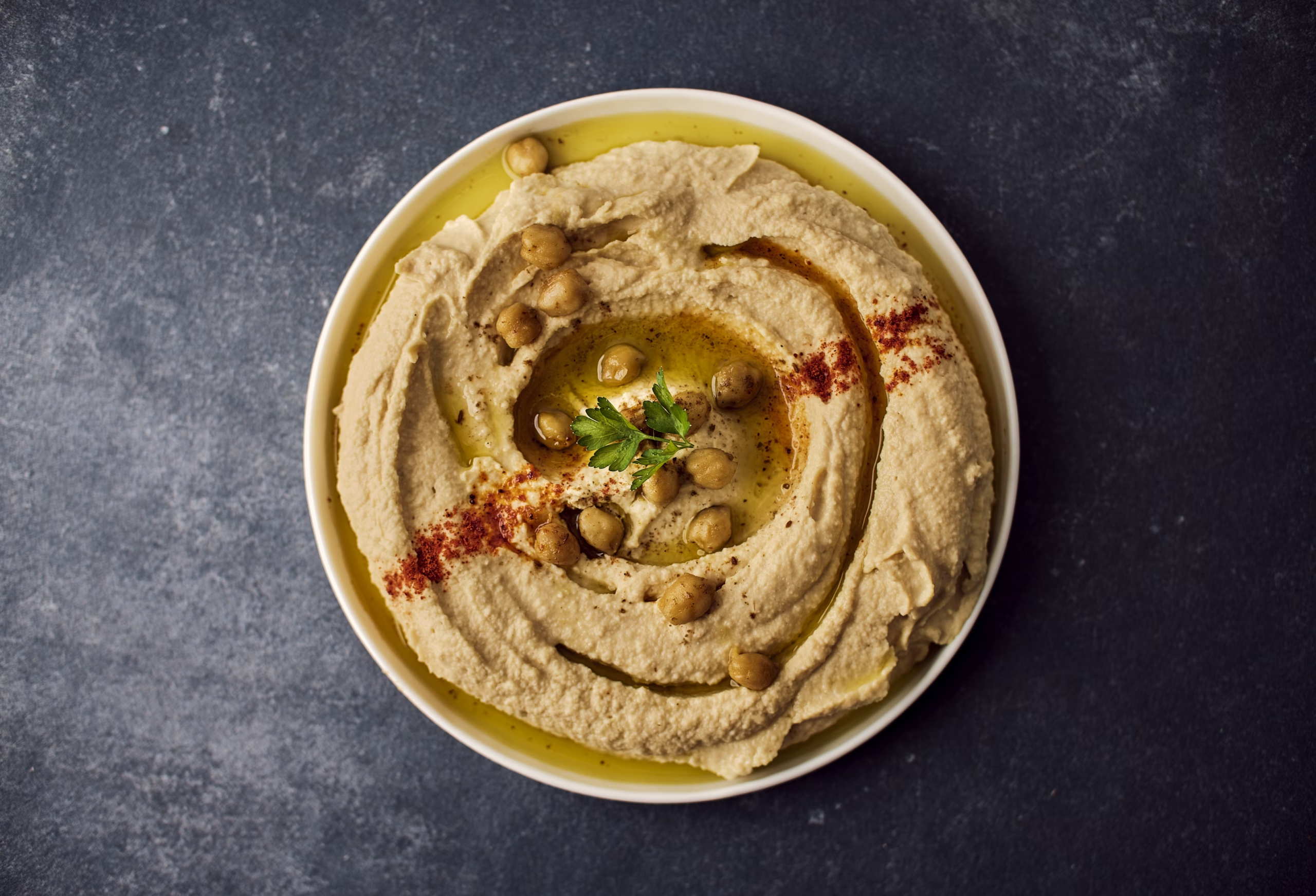Hummus in America: From Ancient Origins to Trending Restaurants
Hummus: The Middle Eastern Staple Winning American Hearts
A classic hummus platter garnished with olive oil, parsley, and spices. This Middle Eastern chickpea spread has journeyed from its ancient origins to becoming a beloved snack across the United States.

Origins of Hummus – An Ancient Middle Eastern Dish
Hummus may be a simple blend of chickpeas and sesame paste, but its exact origin is a subject of lively debate. The dish has been enjoyed in the Middle East for centuries, with chickpeas cultivated in the region for millennia. Some food historians trace an early prototype of hummus (a cold purée of chickpeas with spices and lemon) back to 13th-century Egyp. Others point to 18th-century records from Damascus describing “hummus bi tahini” – chickpeas mashed with sesame tahini – as the first appearance of the classic recipe we know today. While no single country can conclusively claim to have “invented” hummus, it’s clear the dish arose in the Levantine region (the Eastern Mediterranean). Over time, it spread across countries like Lebanon, Syria, Palestine, Israel, Jordan, and Egypt, becoming a shared staple of Middle Eastern cuisine. In fact, pride over hummus runs so high that it even sparked playful “hummus wars” in the 2000s, with Lebanon and Israel dueling over world-record-sized hummus bowls to claim bragging rights for this treasured dish.\
A Daily Staple in the Middle East
In its homeland, hummus isn’t just an appetizer or dip – it’s part of daily life. Throughout the Levant and neighboring regions, people consume hummus at all times of day: as a hearty breakfast, a mezze (small plate) at lunch, or an accompaniment to dinner. In Lebanon, for example, hummus is often eaten as a street food or quick meal; there’s a saying that the easiest way to judge a restaurant’s quality is by tasting its hummus. Many families in Jordan or Palestine might enjoy it fresh from the local hummus shop, garnished with olive oil, warm whole chickpeas, and pita on the side. In Israel, hummus is so ubiquitous that it’s considered a “staple of the Israeli diet,” with some locals eating it nearly every day. Importantly, traditional hummus in the Middle East is made fresh, consumed immediately (often still slightly warm), and treated as a meal in itself – quite different from the pre-packaged tubs Americans know. This cultural centrality helps explain why hummus has been lovingly perfected over generations in these countries. The ingredient list is simple, but achieving the ideal creamy-smooth texture and balanced flavor is regarded as something of an art form. As one Lebanese chef quipped, “It is not a dip, as portrayed in the United States… Hummus is very simple to make; still, it’s very difficult to do a good one.”

Healthy, Plant-Based and Packed with Benefits
Part of hummus’s global appeal comes from its impressive health benefits. This creamy spread is built on nutrient-dense ingredients that fit perfectly into modern wellness trends. Chickpeas, the main ingredient, are high in protein and fiber while being low on the glycemic index (meaning they provide steady energy without spiking blood sugar). A typical 100-gram serving of hummus contains around 7 grams of fiber and 10 grams of plant protein– nutrients that support digestive health and keep you full. It’s also rich in healthy unsaturated fats thanks to ingredients like tahini (ground sesame paste) and olive oil. These heart-healthy fats, combined with soluble fiber, have been linked to improved cholesterol levels and lower risk of heart disease. Nutrition researchers have noted that people who regularly eat chickpeas or hummus tend to have higher intakes of fiber, vitamins (like folate and B vitamins), and minerals such as iron and magnesium. Incorporating hummus into your diet may even promote better weight management and blood sugar control – one study found it helped improve appetite control and replace less healthy snacks in people’s meal patterns.
You might like:
Falafel in America: Origins, Flavor, Food Trucks & How to Find the Best Near You
Kunafa: The Iconic Middle Eastern Dessert Taking America by Storm
Hummus is naturally vegetarian and vegan-friendly, making it a popular protein source for those diets. In fact, it’s often praised as a perfect example of a plant-based protein. Unlike many animal-based dips or spreads, hummus is free of cholesterol and contains beneficial antioxidants. It’s also allergy-friendly: traditional hummus has no gluten, no dairy, and no nuts, accommodating people with celiac disease, lactose intolerance, or nut allergies. The combination of being gluten-free, dairy-free, and high-protein has positioned hummus as a darling of health-conscious eaters – whether you’re a vegetarian looking for a savory sandwich spread, a vegan in need of more protein options, or just someone trying to swap potato chips and ranch dip for a more nutritious snack. With its wholesome ingredients and Mediterranean diet pedigree, hummus has earned a reputation as a guilt-free indulgence that aligns with modern nutritional advice.
Journey of Hummus to the United States
Despite hummus’s ancient roots and popularity abroad, “hummus in America” is a relatively new phenomenon. For much of the 20th century, the dish was virtually unknown to most Americans. Early Middle Eastern immigrants and curious health food enthusiasts were among the few who ate it. In the 1960s and ’70s, hummus gained a small foothold in the American counterculture and vegetarian communities – for example, the influential 1971 cookbook Diet for a Small Planet highlighted hummus as a flavorful plant-based protein source, intriguing some adventurous eaters at the time. Still, it remained a niche oddity. “About 60 years ago, hummus was little more than an unknown in the United States,” one account notes; those who did encounter it often had polarized reactions. Small falafel shops and Middle Eastern restaurants in cities like New York and Los Angeles served hummus to immigrant communities and curious locals, but it would take several more decades (and a lot of marketing savvy) for hummus to hit the American mainstream.
The turning point came in the mid-1980s. In 1986, an Israeli immigrant named Zohar Norman decided to introduce his homeland’s beloved dip to U.S. grocery stores. He founded a company that would eventually become Sabra, bringing refrigerated tubs of hummus to supermarket shelves. At first, hummus still seemed exotic to many American shoppers. The early growth was slow and required consumer education – including in-store sampling to show people how tasty mashed chickpeas could be. A breakthrough moment arrived in the early 2000s when Sabra began an aggressive expansion campaign. In 2004, the brand famously ran a “hummus roadshow” in Costco warehouse clubs, handing out pita bread and hummus samples to skeptical customers. The strategy worked. Americans from California to Connecticut started acquiring a taste for hummus, and demand soared. By the late 2000s, major U.S. grocery chains were stocking multiple hummus brands and flavors, often dedicating entire shelf sections to this once-obscure dip.
Today, hummus is a household staple in America, found in the refrigerated section of virtually every supermarket. Annual U.S. hummus sales, which were negligible 30 years ago, have climbed into the hundreds of millions of dollars. Sabra – now co-owned by PepsiCo – became the market leader that helped popularize hummus nationally, to the point where “Sabra” is practically synonymous with hummus for many Americans. By 2016, Sabra commanded about 60% of the U.S. hummus market, selling roughly $500 million worth of hummus annuall. (For context, that’s about one hummus tub sold every couple of seconds!) The brand’s success not only outpaced competing brands but also proved that hummus had firmly entered the American palate. Sabra’s CEO in the 2010s often remarked that their goal was to have hummus join salsa and ketchup in the pantheon of go-to American condiments – a goal that seems ever closer to reality. Indeed, one New York entrepreneur observed that in 2022, “hummus and pita today is like bagels and cream cheese or bread and butter. Everyone has it in their house.” It’s a remarkable transformation for a food that many Americans hadn’t even heard of a generation prior.

Rise of Hummus Brands and Restaurants in America
As hummus captivated taste buds, it also inspired a wave of new restaurants and brands across the United States. On the grocery side, Sabra’s dominance encouraged competition from brands like Tribe, Cedar’s, and Oasis, all of which expanded their hummus offerings. Even big food companies took note – PepsiCo’s partnership with Sabra and Nestlé’s stake in Tribe demonstrated that hummus had become big business. Grocery stores now stock hummus in dozens of varieties (from classic to spicy to organic options), and sales are projected to keep growing at double-digit rates as more Americans discover this healthy snack.
Beyond supermarkets, a number of fast-casual restaurants have emerged that specialize in hummus and Mediterranean cuisine, riding the wave of the dip’s popularity. Chains like The Hummus & Pita Co. and Hummus Republic are two prominent examples making hummus-centric dining widely available. The Hummus & Pita Co., founded in New York City in 2012, built its menu around fresh hummus bowls, pita sandwiches, and other Middle Eastern-inspired fare. After a successful decade in New York, it began expanding nationally; as of 2022 the chain had multiple locations on the East Coast and even a flagship in Los Angeles as part of a bi-coastal expansion. “We’re bringing hummus to the masses,” its founders proclaimed, noting that what was once a niche ethnic food is now in high demand everywhere. Hummus Republic, another fast-growing franchise, started in California with a modern “build-your-own bowl” concept. The company began franchising in 2018 and has seen remarkable growth – by 2024 it announced plans to open 50 new locations in a single year, expanding into numerous states. The success of these chains indicates that Americans’ appetite for hummus isn’t limited to grocery stores; people are eager to seek out restaurants where they can enjoy hummus in fresh, creative ways.
Even larger Mediterranean-style restaurant brands have helped push hummus into the mainstream. For instance, Cava – now the nation’s biggest Mediterranean fast-casual chain – features hummus prominently in its popular grain bowls and pita wraps. From its humble start as a single Washington, DC shop in 2006, Cava has exploded to over 300 locations by 2024, introducing countless customers to hummus as a flavorful spread alongside falafel or grilled chicken. Cava’s CEO noted that their goal is to make Mediterranean cuisine as familiar to Americans as burgers or burritos, and having hummus on the menu is a key part of that strategy. Traditional Middle Eastern eateries, too, continue to thrive in many U.S. cities – from family-run Lebanese restaurants to Israeli-owned hummusias (hummus-focused cafes) – often earning rave reviews for serving the “best hummus” outside the Middle East. In cities like New York, Los Angeles, Chicago, and beyond, one can find specialty spots that treat hummus with near reverence, topping it with everything from spiced ground lamb to pine nuts and fresh herbs, just as you’d find in Beirut or Tel Aviv. The rise of these restaurants and franchises underscores that hummus has completed its journey from an imported curiosity to an American dining fixture.
Easy to Make: Hummus at Home
Another reason hummus has endeared itself to so many is that it’s astonishingly easy to make at home. Unlike some recipes that call for a long list of ingredients or advanced techniques, a basic hummus requires just a handful of pantry staples. At its core, authentic hummus has only a few key ingredients: cooked chickpeas (often canned for convenience), tahini (sesame seed paste), lemon juice, garlic, and salt, usually finished with a drizzle of olive oil Simply toss these into a blender or food processor and puree until smooth – in minutes, you have a fresh batch ready to enjoy. Countless recipes exist, but most are very forgiving. You can adjust the lemon or garlic to your taste, thin it out with a bit of water or aquafaba (the liquid from chickpeas) if you like a looser texture, or blend extra-creamy by peeling the chickpeas. Some home cooks add a pinch of cumin or paprika for extra flavor, but the truth is you can’t go far wrong with the basic formula.
It’s no surprise that hummus has become a favorite homemade snack for health-conscious Americans. It requires no cooking (beyond opening a can or boiling chickpeas), making it accessible even to novice cooks. It’s also far cheaper to prepare your own hummus than to buy pre-made tubs. Many popular food bloggers and chefs encourage DIY hummus, noting that the flavor and texture can be superior when made fresh – plus you can customize it endlessly. For example, want a roasted red pepper hummus? Just blend in some charred red bell pepper. Craving extra heat? Throw in a jalapeño or a dash of cayenne. The versatility and simplicity of hummus have turned it into a homemade staple in kitchens across the U.S. In fact, surveys show that a significant percentage of American consumers who enjoy hummus have tried making their own at least once. With such an easy, flexible recipe, hummus invites creativity while virtually guaranteeing a nutritious result. Whether you follow a traditional Lebanese cookbook or a quick TikTok recipe, the “dip that anyone can whip up” has firmly planted itself in American home cooking.

American Innovations: Flavors, Toppings, and New Twists
As hummus settled into American food culture, it didn’t remain static – enterprising chefs and companies began experimenting with new flavors and creative twists to entice the American palate. Early on, brands realized that one way to win over U.S. consumers was to incorporate familiar flavors into this unfamiliar spread. “Take something that’s new to the American consumer, like hummus, and then add ingredients they know and love,” explained one marketing director. Sabra exemplified this approach by rolling out a line of flavored hummus: instead of just the traditional chickpea-tahini-garlic blend, they introduced varieties like roasted red pepper, sun-dried tomato, olive, and jalapeño hummus. These hybrid creations combined the essence of hummus with flavor profiles Americans recognized, making the dip more approachable for the uninitiated. The strategy paid off – flavors like roasted garlic and red pepper quickly became top sellers in the U.S., even though such additions are non-traditional in the Middle East. Other brands followed suit: Tribe and Oasis (fellow pioneers from the 1980s) launched everything from spinach-artichoke hummus to spicy sriracha hummus. Before long, supermarket shelves in America held more than just “classic” hummus – shoppers could pick from a rainbow of options, each with an Americanized spin.
Innovations weren’t limited to savory flavors. In a development that purists never saw coming, the 2010s gave rise to dessert hummus – sweet versions of hummus designed to be eaten with fruit or graham crackers. This trend, which started with small startups and later caught the eye of big players, essentially swaps out garlic, lemon and olive oil for ingredients like chocolate, vanilla, or pumpkin spice blended into the chickpea base. By 2017, brands like Delighted By were selling chocolate chip cookie dough hummus and brownie batter hummus at major retailers, pitching them as “guilt-free” desserts packed with proteineater.com. The concept sounds quirky (and it did spark some controversy and social media debate), but curiosity among consumers was high – so high that even Sabra tested a limited-run dessert hummus (a chocolate spread) in 2020eater.com. Not to be outdone, The Hummus & Pita Co. added its own creative confections: in 2016 the restaurant introduced a line of sweet hummus flavors like cake batter and cookie dough, and soon after it debuted a frosty blended hummus “milkshake” called the Chickpea Chillereater.com. (Yes, a hummus milkshake – it’s a real menu item, and it’s entirely vegan!) These offbeat interpretations are a distinctly American extension of hummus’s evolution.
Beyond flavors, American eateries have popularized a variety of toppings and serving styles for hummus. It’s now common to see hummus served as a loaded bowl, piled with toppings like spiced ground beef or roasted cauliflower, a drizzle of chili oil, fresh herbs, toasted pine nuts, or feta cheese. Chefs draw inspiration from Mediterranean and Middle Eastern traditions (for instance, topping hummus with sautéed mushrooms or hard-boiled egg, which is done in parts of the Levant) and also invent new combos to appeal to local tastes. In some trendy U.S. restaurants, hummus is presented as the centerpiece of a meal – perhaps a generous swirl of hummus in a bowl, heaped with salad, grilled protein, pickles, and pita on the side, effectively turning it into a hearty entree. This concept of a “hummus bowl” or “hummus platter” has resonated with customers looking for healthy, flavorful lunch options. It’s a far cry from the basic carrot sticks and hummus dip cup that many Americans started with. From Buffalo-wing-flavored hummus to dessert hummus dips, these innovations show how hummus has been adopted and adapted in the American food scene. While some traditionalists roll their eyes at chocolate hummus or extra-spicy jalapeño hummus, there’s no doubt that these creative riffs have helped broaden hummus’s appeal. They demonstrate the versatility of the humble chickpea purée – proving that a 1,000-year-old dish can still feel fresh and exciting in the 21st century.

Finding the Best Hummus Restaurants Near You
Hummus’s popularity means that you don’t have to look far to find a delicious version near you. In most American cities today, you can discover Middle Eastern restaurants, Mediterranean grills, or specialized hummus bars serving up authentic and innovative takes on this creamy dip. To find the best hummus restaurants in your area, a great place to start is the Rakwa directory, an online resource for Middle Eastern and halal restaurants. Simply search for “hummus” on Rakwa to see a curated list of eateries known for top-notch hummus (from cozy local kitchens to popular chains) in whatever city or state you’re in. It’s an easy way to read reviews and get directions to hummus spots you might not otherwise hear about. Craving to try that silky smooth hummus you’ve read about? Go ahead and search the Rakwa directory for hummus restaurants near you. You just might discover your new favorite lunch place or grab-and-go snack. Whether you’re in California or Connecticut, there’s likely a restaurant nearby where chefs take pride in serving authentic hummus – perhaps topped with olive oil and paprika in the traditional style or spun into a creative fusion dish. Hummus in America has truly gone from an unknown import to a national obsession, so dive into your local scene and enjoy this nutritious, delicious gift from the Middle East. Your taste buds (and health) will thank you, and you’ll be joining countless others in saying “more hummus, please!”




I’m also writing to let you understand what a beneficial discovery our child found reading your web page. She noticed so many pieces, with the inclusion of how it is like to possess an amazing teaching style to let most people without problems grasp a variety of tricky matters. You actually did more than her expectations. I appreciate you for supplying such essential, trusted, explanatory and also cool tips on this topic to Julie.